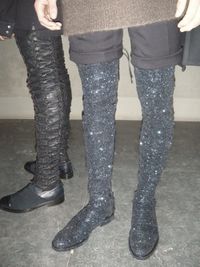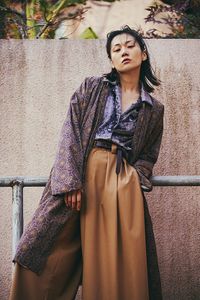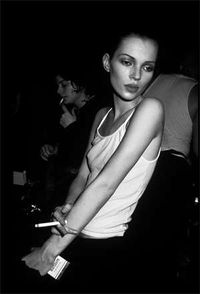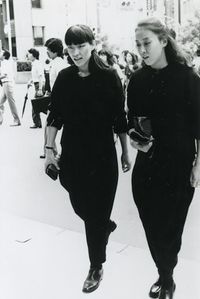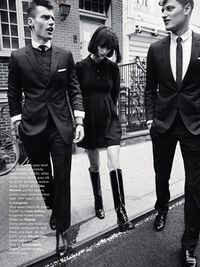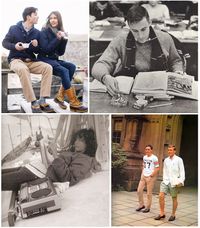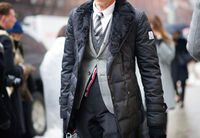Styles
If you haven't read the Introduction, then do it now. This page is for different styles, not only in fashion, but also in the life you lead. Many people disregard their day-to-day life when attempting a new style, and this is where they fail. Be concise when looking for your ideal style. Don't be a try-hard, don't be an actor.
Please Note: Categorizing fashion into "styles" like they were animals in a taxonomy, while convenient for the beginner, is actually a terrible view to adopt. Outfits cannot be "categorized" into styles completely because each one is unique, and many deviate from these supposed "styles". Styles are not objective. For more information on developing your personal style, see "Taste" in Introduction.
Contents
Artisanal/Avant-Garde
Examples of Brands: Rick Owens, Yohji Yamamoto, Julius_7, Ann Demeulemeester, Maison Martin Margiela, Comme Des Garcons.
Artisanal styles are a generally less accessible and remain a niche aesthetic due to high prices and exclusivity. The style is informally referred to as "goth-ninja" on /fa/ or derisively as "goof ninja." The usual defining features of this style are a monochrome / grayscale color palette, unconventional proportions, textures, construction, unique materials.
It is a subjective term and therefore there are no real boundaries or rules that dictate whether an unconventional "Dark" look is "Avant - Garde" or not. Ideologies and Philosophy are an important part of the aesthetic, and many of the designers make conscious efforts to differentiate themselves from mass produced garments with no meaning, depth, or "Soul".
Many pieces are made with unique techniques, treatment (dying, tanning, distressing), and materials. Often, brands place a strong focus on distinctive or unorthodox construction of pieces, for example rather than using a conventional nylon lining in a blazer, it will be unlined with raw edges on the inside, or the lining will be made of a linen/nylon blended fiber.
A vast majority of "avant garde" brands place a strong priority on being anti-branding, using minimalist logos on the interior of pieces, generally placing priority on the construction, form, and quality of the garment, above the brand that created it.
Many of the people who appreciate this aesthetic share the same appreciation for craftsmanship, modern design, and anti - consumerism.
Bohemian
Representing the practice of a bohemianism: someone who lives the unconventional lifestyle in pursuit of artistic, literary, or spirutual interests. The bohemian subfashion often popular today, known as "boho-chic" is not representable for the style and those that particpate are seen as victims to the irony of women trying to look nomadic, outliers, following the trend where as gypsy girls themselves were seen as exotic, sexy, and independent.
To better learn how to wear this style it's important to know its general history and where in my personal opinion, lost its charm. As of the early 19th century, role of the bohemian culture was connected to the young French working class women known as grisette. They worked with prostituition on the side of other jobs such as seamstresses and models. It was in the 20th century, where women in the west began moving outside of their traditions and became more independent, during this time they adopted wearing full skirts and bright colors, bobbed hair and androgynous traits. Seeing the growth of mass adoption of this style by many hippies and fememinists of the 1960s, the start of Boho-chic (Bohemian Homeless) comes onto stage taking the attention of the famous and "fashion-forward" which have followings of young women who are impatient and egar to find and wear whatever their idol is into made it a must have of fast fashion brands to put on their shelves. Ruining the authenticity of Bohemian's exotic and independent nature.
There's much more to influenced by for those intrested in taking on this style. The bohemian style has went through many phases and infused with different influences that it should be seen as a fashion with no defenitive marker like lunarcore. But up the wearers artisitic and spiritual interests shape what their wear, making this a very experimental and personal style.
Heroin Chic
Examples of Brands: Yves Saint Laurent (Hedi Era), Dior Homme (Hedi Era), Saint Laurent Paris (also Hedi Era)
More of a "look" than a style of dress, heroin chic became popular in the 90's starting with a Calvin Klein runway show featuring Kate Moss and a series of Vincent Gallo photos featuring emaciated, pale, drug-addicted looking models. Heroin prices were dropping and the purity was much better at the time, which helped increase its popularity.
The style was dead in the magazines when, Gisele Bundchen was dubbed the new supermodel in 1999. Nowadays, though, it carries on in fashion with a much lighter tone thanks to our teenagers who insist on dying due to anorexia which, as a result, places Heroin Chic in poor light.
Karasu Zoku
Standing for crow tribe. Karasu zoku is a 1970s japanese punk movement where women would dress head to toe in black. It began to take center stage in the west as counter culture to the extravagant and essentric styles of the 90s. Described as dark, violent, and conceptual. The style was born from the cultural and politcal turmoil of the era with Hiroshima, Chernobyl, and the economic crisis faced afterwords.
The stlye made popular by japanese desginers: Yohji Yamamoto and Rei Kawakubo came with the idea that the modern women would no longer need to submissive to men, but now a new kind of women who did not seek to please, who asserts their personality and independence. Hence the name for Kawakubo's line Comme de Garcon or "Like boys".
"The customer request: they wanted to become very feminine, very sexy, very like dolls, and I hated it. Begrudgingly, I wanted to create my own new line for women, because the owners were too girlish. I wanted to design manish clothing for women from the beginning. Very often my costumers didn't pay with their own money, their partner paid. I would shout in my mind ... 'Bitch'. I couldn't stand on desinging bitches clothing" -- Yohji Yamamoto
Military-esque
Military-esque fashion is the adoption of gear from armed forces or those inspiried. Many military's uniform have gone through a period of changes counting for the time period, the country, and the situation they find their soilders to be in. Taking this into account, driving inspiration from the battlefield opens to a lot of experimentation in this style, but also being incredibly apporchable. With military surplus stores an abundence in places such as the United States and thirft stores often carrying left over clothes from ex-military.
Lunarcore
There is no definitive marker of 'spacecore'. The style itself is rooted in choosing garments that fit a specific feeling, thus forcing the wearer to mine various designers for unifying threads and in doing so reject the vision offered to them as consumers. The unifying thread is retrofuturism, but could just as well be post apocalyptic cowboys as far as the ethos is concerned. What we are doing is using pre-existing products to make a non-existent statement. We are turning the product into the means of production. Like sampling records, but with moods and styles. Space/Lunarcore is about how you use what you have access to in order achieve a look. Color is far more important than in the drapey black stuff /fa/ usually goes for. You need to think critically, build a narrative around your clothing and color choices. Things become appropriate and inappropriate according to how they are framed within the fit. You need to use pieces as symbols and signifiers, telling a story with your outfit.
Radical chic/Terrorist chic
Refers to the appropriation of symbols, objects, and aesthetics of associated with the looks of militants and terrorists, usually in the contest of pop culture. The term Radical chic comes from the 1970s essay "Radical Chic: The Party at Lenny's" by Tom Wolfe to describe Leonard Bernstein for hosting a fundraising party for the Black Panthers. He discribes the radical chic as the promotion of radical political caused by celebrities, socialites, and high scoiety. Defining their allegiance through what they wear, they are ideologically invested into the cause and often refrain from enganging or as dedicated as activists or revolutionaries. Terrorist chic which is more popular today is associated itself closer to the iconography of terrorists such as those in the Irish Republican Alliance.
Mod
"For the fashion-obessive and hedonisitc cult of the hyper-cool" as discribed by Paul Jobling and David Crowley the spread of the Mod subculture came from the influence of post socioeconomic troubles that plauged London. The youth of the 1960s became the first of their generations with the ability to be induldge in themselves. Instead of using their money to help the family as previous generations had to do, teens were able to use their income on their presentation.
Men took up a clean, sophisticatd look with tailor-made suits with narrow lapels, thin ties, button-down collar shirts, wool or cashmere jumpers, military parkas, and chelsea or beatle boots. Often going against gender norms using makeup such as eye shadow, pencil, and even lipstick.
Women dressed androgynously, with short haircuts, men's pants and shirts, flat shoes, and straying from too much makup, but took up progressivly shorter miniskirts.
The mod subculture was influenced by not only their fashion, but music such as soul, ska, and R&B, but also motor scooters as the concealed moving parts made it easier to avoid oil or road dust on their clothes. Another notable part was the recreational use of amphetamine, their popularity with the crowd came for the fact that it was still legal in Britian.
Prep
Examples of Brands: J Press, Brooks Brothers, J Crew, Polo Ralph Lauren, Lacoste
Similar in some ways to traditional menswear, but with key distinctions, "prep" is a style that evolved on Ivy League campuses in the mid twentieth century and came to exemplify New England's white upper middle class. Given the influence of collegiate and prep school environments had in shaping the style, prep modes of dress are more casual, youthful, and sporting in nature than traditional menswear. Prep clothing often pays homage to upper middle class leisure activities like equestrianism, sailing, yachting, hunting, rowing, lacrosse, tennis, and rugby. In fact, many prep essentials originated as sportswear like the canvas tennis sneaker, the polo, and the waxed hunting jacket. Embroidered pants may feature nautical symbols, ducks, or hounds. Nautical stripes and boat shoes hearken to sailing and the significance of fishing to the region.
As a result of these influences, women's prep styles will often appear androgynous, forgoing skirts and adopting pants, shorts, crew neck sweaters and men's button downs.
Prep Essentials: white trainers (canvas or otherwise), wool crew neck sweaters, striped sweaters, chinos, braided leather belts, boat shoes and loafers, a sportscoat, polos, oxfords (both the shoe and the shirt), madras, tweed, duck boots.
Traditional
Examples of Brands: Thom Browne, Tom Ford, Isaia, Brioni, Ralph Lauren Purple Label, Martin Greenfield, Calvin Klein Collection
Menswear is a modernized style that draws from conservative or classical male working aesthetic. Masculine silhouettes, formal incorporated into casual attire, and somewhat preppy styles fall here. Fit and fabric serve great importance in menswear outfits, as well as in controlling the quality of the clothing you purchase. Cheaply made, ill fitting menswear is a recipe for disaster, as it is very easy to come off as sloppy or trashy. Keeping this in mind, a crisp tailored button-down, slim-fitting trousers, a pair of casual oxfords, and a relatively casual tie, for example, can be worn to either a job interview or a night out.
In the debates that take place on /fa/ and elsewhere, styles are often given names by their opponents to mock and ridicule its followers. The derogatory term used to describe menswear is "dadcore". As the style's classical aesthetic is associated with the older generations (as in being "clothes for dads") menswear has been mocked as such. However, the nickname has since turned into the term used for failed attempts at menswear which include fedoras, ill fitted suits and generally horrid taste.
Clothing in this type of style highly emphasizes construction, material quality and the difficult pattern-making work. Such examples include Loro Piana who is known for cashmere, Ermenegildo Zegna for their wool, and bespoke labels.
